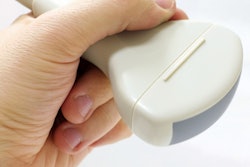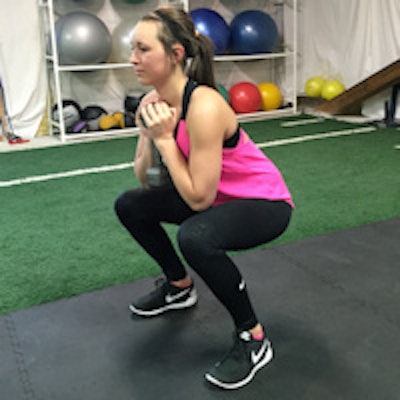
Is your butt the cause of your back pain? It could be. As we near the end of this seven-part series on sonographer back pain, we're sharing some stretches and exercises to address the common problem of a weak or imbalanced backside.
Imbalances or a lack of strength or activation in our glutes can be caused by a number of issues, such as past injuries and current pain that changes movement patterns. It can even be due to inactivity (i.e., sitting too much).
As with any of our previous solutions for addressing back pain, it's important to understand that it's going to take some time to correct the problem. Think of it as having a bad electricity problem in your house that will require rewiring of the whole home. That isn't a quick fix, and it's the same with your body's wiring. Right now your glute is weak and might not want to work how it's supposed to.
To help get your "butt in gear," here are six things you can do.
Isometric contractions
To fix a butt imbalance, you need to work the weaker glute. Isometric contractions are a great way to do this. Think of tightening the muscle with no movement, just as you would in flexing your bicep to show your arm muscle. Try these contractions each day if you have time, resting for five seconds in between each hold:
- 10 sets of 3-second (maximum) contractions with the weaker glute from a standing position; think of squeezing one butt muscle on each of these, letting the other stay relaxed
- 10 sets of 3-second (maximum) contractions with the weaker glute from a seated position
- 10 sets of 3-second (maximum) contractions with the weaker glute from a prone position
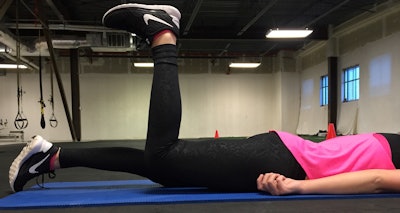 All images courtesy of Doug Wuebben.
All images courtesy of Doug Wuebben.What's great about these exercises is that you can do them anytime and anywhere. Want to do them at work? No problem. Nobody will even know you're doing them unless they are looking right at your bottom, and they might just think you have to use the restroom!
Low-load dynamic drills
In addition to the isometric contractions, it's helpful to perform a variety of dynamic movements. You do not want to go to failure when performing sets of these exercises. Two to three days per week is good, but it's even better if you can work in more. All you need is five to 10 minutes to work that weaker glute. Perform the following exercises in order in a circuit, resting 30 seconds in between sets:
- 2 sets of 10-20 reps of side-lying abductions with the weaker leg
- 2 sets of 10-20 reps of side-lying clams with the weaker leg
- 2 sets of 10-20 reps of quadruped hip extensions with the weaker leg
- 2 sets of 10-20 reps of single-leg glute bridges with the weaker leg
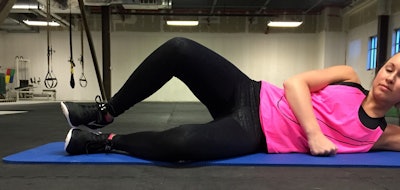
Low- to medium-load bilateral movements
Every repetition of squats, deadlifts, hip thrusts, and back extensions should be as symmetrical as possible. Don't shift to the strong glute; this causes more harm than good. Instead of worrying about how much weight you use, be sure to use proper movement patterns.
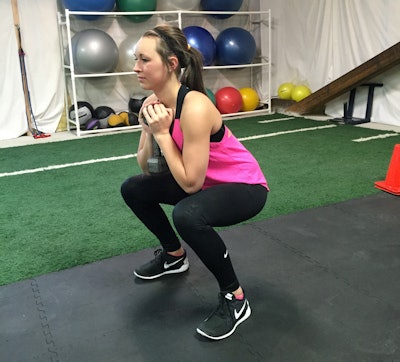
When you go too heavy with weights, your body will find the path of least resistance in order to get the job done. One of your glutes is weaker than the other, and if you push the envelope, your body will work around it by using other muscles and contorting your position (i.e., shifting to one side or rotating at the hips).
Bilateral movements with resistance bands around the knees, ankles, or feet
Body-weight squatting and bridging patterns with resistance bands around the knees are great for getting the glutes to fire. These have different names, such as x-band walks, sumo walks, and monster walks.
We recommend placing bands around the ankles and doing movements from both an athletic position and also a tall and upright position. We also have our folks do forward and backward as well as lateral, or side-to-side, movements. Be sure to keep the shoulders and hips level, and don't lean back and forth during the movement.
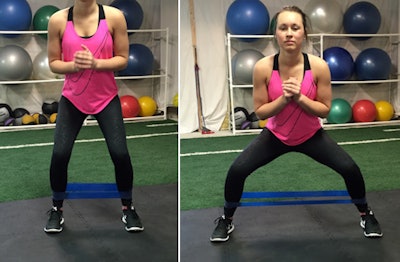
Single-leg movements and core stability drills
It's also useful to try some traditional single-leg exercises, such as Bulgarian split squats, step-ups, reverse lunges, single-leg Romanian deadlifts (many of these are discussed in our previous articles), single-leg hip thrusts, and single-leg back extensions. Core stability work, such as Pallof presses, side planks, and band hip rotations, are also important.
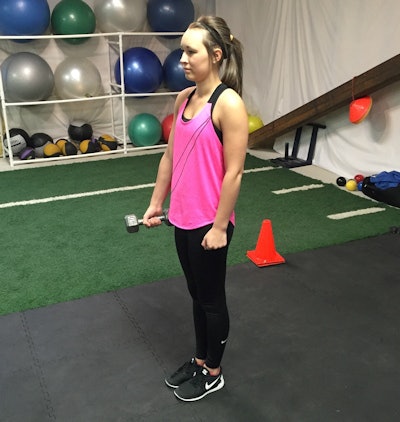
Self-myofascial release and static/dynamic stretches
It is very important for your hip mobility to be even on both sides. If one side has more mobility than the other, this can lead to glute problems.
To assess your hips, do a self-test for hip mobility with both legs in all directions. If you see a significant difference, some stretching and myofascial release can help. Incorporate foam rolling, static stretches, and dynamic stretches to help achieve balanced flexibility. These sessions don't have to be long: five to 10 minutes is fine. The key is to be consistent in performing the exercises.
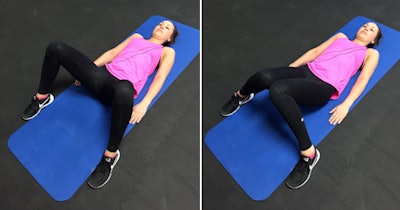
Balance is the name of the game
By doing a combination of these exercises, you can strengthen your glutes and maintain balance in your butt muscles, which will help improve your back. Just be consistent and diligent, and you should be able to restore proper function and strength.
Stay tuned for our last article in this series. We'll share how some simple lifestyle changes can greatly affect your back and help you live pain-free in all areas of your life.
Doug Wuebben is a registered echocardiographer and also a consultant, international presenter, and author of e-books in the areas of ergonomics, exercise and pain, and injury correction for sonographers. He has also been published on the topics of telemedicine and achieving lab accreditation.
Mark Roozen is a certified strength and conditioning specialist, a certified personal trainer, and a fellow of the National Strength and Conditioning Association (NSCA). He also consults, presents, writes, and works with groups, teams, and organizations around the world. He has been in the strength, conditioning, and performance field for over 30 years.
Wuebben and Roozen are co-founders of Live Pain Free -- The Right Moves. Email [email protected] or go to coachrozy.com for more information on programs, training, or speaking requests, or if you have any questions or comments.
The comments and observations expressed do not necessarily reflect the opinions of AuntMinnie.com.






